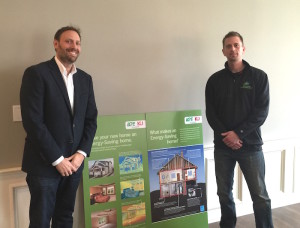
08 Feb Energy Efficiency With Eric George From Building Performance Group
Transcript:
 Jason: Today I am happy to have the pleasure of Eric George with Building Performance joining me on this week’s podcast. I thought it would be a good opportunity to learn a little bit more about smart building and how to build an efficient home. With that great introduction, I want Eric to introduce himself and really want to welcome him to the podcast today.
Jason: Today I am happy to have the pleasure of Eric George with Building Performance joining me on this week’s podcast. I thought it would be a good opportunity to learn a little bit more about smart building and how to build an efficient home. With that great introduction, I want Eric to introduce himself and really want to welcome him to the podcast today.
Eric: Thanks, Jason. I appreciate it. Yeah, my company is Building Performance. We do home energy ratings for new construction. We also do energy audits on existing homes. The focus mainly of our business is new construction these days, because a lot of what we do is actually required by code now.
Jason: That is interesting. Most guys, I guess, aren’t voluntarily using your services. Do they have to use your services?
Eric: They don’t have to use our services. The way the energy code is written these days, you have different paths for compliance. You’ve either really got the prescriptive path of compliance, which is you follow the code to the letter, or you have the performance path of compliance. For example, if you’re building homes that are … When you spray foam like the roof line, when you spray foam the roof line, you’re conditioning the attic space. Typically they don’t put an R-38 worth of spray foam on the underside of the roof, so it’s actually less than the prescriptive requirement for the code. When you do something like that, the code says, “You need to use an energy rater to actually model the efficiency of the house as a whole, and that way it will prove compliance via an alternative method.” Does that make sense?
Jason: Maybe we should back up a little bit. Why don’t you talk me through just the step-by-step process of what your services do? I’m building new homes, new luxury homes here in Louisville and I like your services. I think they’re very valuable. From the beginning of the process to the end, walk me through, and the listeners through, what that process entails.
Eric: Okay sure. The home energy rating process is basically a three-step process. The first step is, we get a set of plans from you. You tell us how you’re going to insulate the home, the type of windows you’re going to put in, heating/cooling system information, and we put everything into a software program that does what’s called energy modeling on the house. It will tell us several different things. It will say, “Yes, the house is going to comply with the code,” or, “No, here it won’t, and here is why.” It will tell me what the heating and cooling load for the building will be, so you can size your HVAC equipment properly. It’ll also tell me what the projected utility cost for the building should be, given a bunch of different factors, and what the projected energy rating … the score will be for the house. That’s the first step.
At this point you can change variables. You might have a client who is thinking about doing Geothermal, or maybe spray foaming the house versus just the traditional fiberglass bats. What our software will allow you to do is play with those variables and see how it effects the heating and cooling cost for the house, the score and some other factors. That’s the projected rating, step one. Step two is we come out before the house ever gets covered up with drywall. We look at the insulation installation quality, make sure it’s been insulated properly. We look for proper air sealing. The framing needs to have proper blocking between condition space and attic space. We make sure the duct system has been sealed properly, bath fans and other exhaust vents have been run properly outside so they’re not bent or restricted. There is a check list that we go through.
We take pictures of the house during this process. Any issues we find, we share with you, the builder. Then we pretty much don’t come back until the house is almost done. The third step of the process is our final inspection. This is where we actually test the house and verify that it’s operating the way that we intend it to. We do an air leakage test on the house with a tool called a blower door. Basically that simulates 20 mile and hour winds hitting the house from every angle at the same time. It sounds crazy, but it’s a building science standard for testing how tight or leaky a house is.
We also test the duct leakage on the systems. Both of these things are actually required by code, but they’re not really well-enforced in Kentucky. Air leakage tests, duct leakage tests … We test exhaust flow ventilation. We check the attic insulation, foundation insulation, and as long as everything is good, we leave a code-compliant sticker on the panel, and we put all that data back into our software, and it gives you a final confirmed rating for the house.
Jason: Okay, and is that what you call a HERS rating?
Eric: That’s a HERS rating, yes.
Jason: Okay, and what is an acceptable number, and what are guys striving to achieve?
Eric: In our climate zone, which is Climate Zone 4, it covers basically all of Kentucky and the Southern part of Indiana, most of the time what we see is an average score somewhere in the 70s. For the State of Kentucky, I’d say it’s probably in the mid 70s. It’s an average score. Most of the homes that we inspect for you are usually in the 50s and 60s. There’s different things that can reduce your score, which means improve. The energy rating score is between 0 and 100, whereas it’s like golf, the lower the number, the better the score.
Jason: I can relate to that one, being a golfer, so all right, I appreciate that.
Eric: Average score being 75-ish. A house that was build … Most older existing homes average somewhere around 130 to give you a frame of reference.
Jason: Wow.
Eric: The best that score could really be is about a 0, meaning that over the course of a year, the home does not consume anymore energy than it produces. You can typically only get to that point with Geothermal, or using solar panels, in really high performance homes.
Jason: Talk to me about, if you do want to get a lower score, how much would doing a Geothermal heating and cooling system versus a traditional four-stair system affect your score? I know there’s other variables.
Eric: Sure. Typically when we have a house that has a Geothermal system in it, it’s going to be somewhere in the 50s … is typically where it comes out at. If it’s a gas system, it might be in the mid 60s. Geothermal is usually going to be in the 40s or 50s, depending on what else they do to the house. A heat pump system would typically be in the 70s or 80s.
Jason: What’s the lowest rated house you’ve tested recently? What number would that be, just to give our listeners a frame of reference for the most efficient built house around Louisville, say?
Eric: The lowest score that I’ve ever rated is a 34, and that was a couple of years ago. The most recent best score that I can think of is probably maybe a 39 or a 40. Typically those houses, again, they have Geothermal. They’re either really well air sealed or they have spray foam insulation. They almost always have mechanical ventilation, so controlled fresh air coming into the house.
Jason: Explain that. A lot of people get concerned when they come to me about, “Oh, I don’t want my house being too tight. I hear that’s a bad thing.” Is it a bad thing to have a house too tight?
Eric: There’s a lot of misconceptions about houses being too tight and making you sick, and all that stuff. Really it comes down to a lack of education. The simple answer is no, you can’t make a house too tight, because as long as you provide controlled ventilation … If your bath and exhaust fans are working properly, you’ve got a kitchen exhaust hood. It’s getting the moisture out of the house, then it doesn’t matter how tight the house is, as long as you’re controlling the moisture sources. The problem is that most people have lived in older homes that are leaky and they’re not well-insulated, and so if there is any moisture buildup inside the house from taking baths or cooking, or whatever, that moisture is naturally ventilated out of the house because the house is leaky. It doesn’t mean that the ventilation is actually working in the house. It more means that the house is just leaky.
When you start making a conscious effort to build a really tight, well-insulated, well-air sealed home, you have to make even more attention to making sure that the ventilation works properly. Again, as long as you are managing the moisture inside the house properly as well as outside with proper drainage and grading, then you shouldn’t have any issue with moisture buildup inside the house.
Jason: Define a mechanical ventilation. Can that be controlled with just a simple exhaust fan over a range and the bath fans, or do you need something more than that?
Eric: That would be the basics. There’s three forms of mechanical ventilation, and they’re basically exhaust only, exhaust fans, supply only, which is an air cycler, where it brings in fresh air straight into the duct system of your system, and then balanced systems. Those are ERVs and HRVs. Those are the Cadillac’s of the mechanical ventilation. They’re also the most expensive. When you build a high performance home, especially if you spray foam the whole thing and it’s really, really tight, an ERV or an HRV is the way to go. Not only is it exhausting air in a controlled manner, but it’s bringing in fresh air in a controlled manner. It’s not, without getting too technical, it’s basically not bringing in … If it’s the winter time, it’s not bringing in cold air. It basically does not allow the cold air to come in, it just allows the fresh air to come in. It’s a complicated concept, but just know that it’s a well-controlled fresh air intake and exhaust system, an ERV.
Jason: I think that’s where a lot of people have misconception about the energy, the ERVs and HRVs, is that they’re going to bring in the cold air and change dramatically the temperatures, but that’s not the case. Sounds like that could be a whole another episode on ventilation for a house, but we won’t go into that today.
Talk to me about the energy efficiency of these houses. If you’re talking HERS rated houses up in the 50s to 40s, and I know we build houses from 2,000 square feet to 10,000 square feet, but on the typical house you do maybe a 3,000 square foot house. Do you get into meeting with the end consumer, or are you strictly just meeting with the builder? Are people really concerned about the utility bills and how can I get my bill from $500 or $600 a month to $200 to $300 a month? Can your software do that? What variables are going to really increase the efficiency of these houses?
Eric: Yes, sometimes we get pulled in by the homeowner first. The homeowner will find us either online or from a referral from somebody else who we’ve worked for. They may already have a builder that they’re working with, but they want an unbiased third party to make sure everything goes well. Yes, we do work with homeowners directly fairly often, but most of the time we actually get brought in by the builder, and the builder sees us as the well-trained set of eyes that is looking at the insulation, the heating/cooling, the duct system, and the house as a whole, maybe in a way that he’s not or his superintendent isn’t, and so it’s a quality assurance for the builder. Yes, we do work with the homeowners, but more often we work directly with the builders. What we try to do is figure out, first of all, what is their budget, I guess, for the improvements that they’re talking about. You can spend a ton of money on energy efficiency improvements, and they not necessarily pay for themselves in a quick manner.
Jason: Sure.
Eric: Some of the things that will pay back really quickly … What we’ve found are using LED light bulbs and CFLs, although CFLs are on the way out now. LEDs are almost the same price as CFLs and believe it or not, if you put all LEDs in a house, versus the exact same house that has all of the traditional incandescent light bulbs, the score of the house will drop by 7 to 10 points, improve 7 to 10 points.
Jason: Just on the light bulbs.
Eric: Just on the light bulbs alone.
Jason: Wow, it seems like every day when I go through Lowe’s or Home Depot, they’re really pushing the LED bulbs. It’s amazing that they can have that type of impact on the efficiency of the house.
Eric: They last for 20 to 30 years, is the crazy thing. Even if you move out of the house, take the light bulbs with you. Light bulbs are a good return on investment. Heat pump water heaters are another good return on investment. Also instant gas water heaters, but that depends on how many people are in your house and how much you’re using on a regular basis. The software gives the same credit for a heat pump water heater as it does for a natural gas water heater, but the reality is they could perform a lot differently, depending on your family. We’ve got light bulbs, heat pump water heaters, using mechanical ventilation, actually. It’s a software thing, the software doesn’t really give you credit for having a super-tight house, unless you have mechanical ventilation in the house. You could do everything else right, air seal the heck out of it, spray foam the house, whatever, but if you don’t install mechanical ventilation, the software is going to say, “Time out. You’re not getting credit for this, because you’re not doing it right.”
You don’t ever want to build a super tight house without providing some form of mechanical ventilation. When you do, again, it will improve the score probably 5 to 7 points.
Jason: Okay, wow. That’s a couple of quick ways to get some… instead of maybe investing 20, 30, $40,000 in a Geothermal system, which is still a great investment, you could spend a couple of hundred bucks at Lowe’s with some LED light bulbs and really see some pretty substantial savings.
Eric: Yeah, typically air sealing the house and providing mechanical ventilation is going to give you a good return on investment, no matter what type of insulation you use. Obviously we like blown-in insulation products like blown-in cellulose or fiberglass for walls. Spray foam is a great product as well for walls. We prefer to see spray foam used where it’s most effective, roof lines, vaulted ceilings, rim joists that are difficult to insulate and seal, and then it might be more cost-effective for your home owners to do a blown-in cellulose or fiberglass in the above-grade walls.
Jason: Bringing on insulation, and talking through that, that’s I think a very important topic. All of my customers are very, very in-tune with insulation. What I may do … we’re running a little bit long on time here, is bring you back for another episode maybe here in a couple of weeks and maybe we can talk more about insulation and continue our talks. Why don’t you give folks a good way to contact you, if they do have questions, or want to hire your services.
Eric: Okay, sure. Our number is 502-509-5535. Our website is buildingperformancegroup.com.
Jason: Eric, once again, thank you for joining us today. I look forward to have you back here soon.
Eric: I appreciate it.



